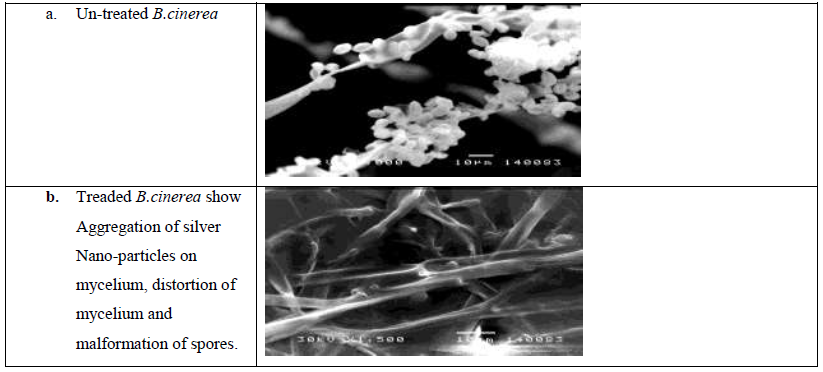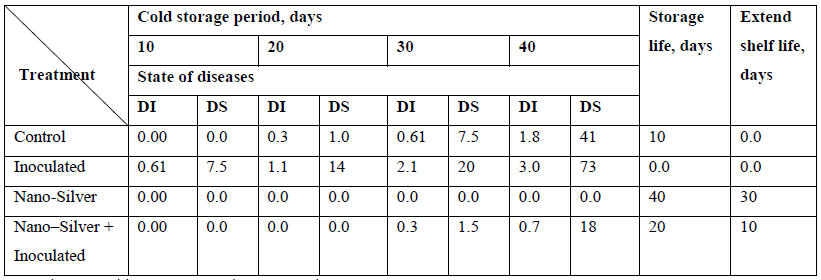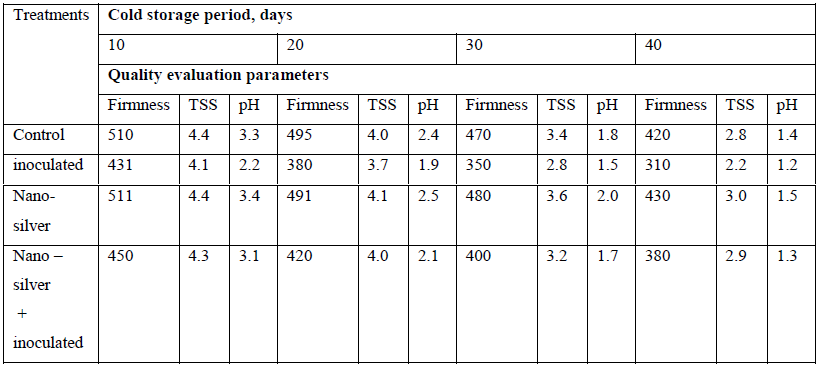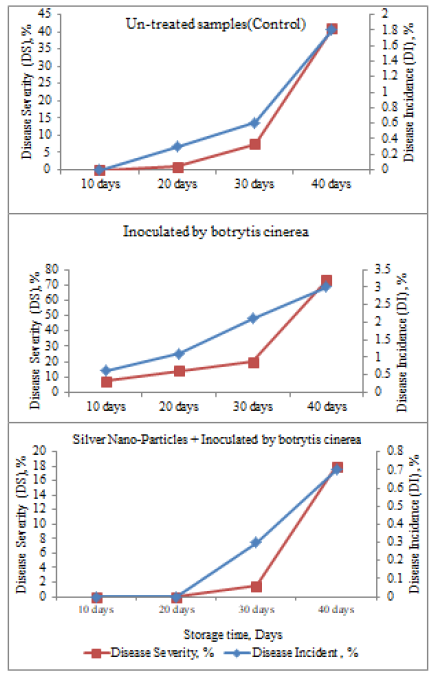Effect of Silver Nano-Particles on Gray Mold of Tomato Fruits
Ehab Ahmed Salem1, Mohamed Abdel Salam Nawito1, Abd El-Rahman Abd El-Raouf Ahmed2*
1Food Irradiation Department, National Center for Radiation Research and Technology (NCRRT), Atomic Energy Authority, Egypt
2Agricultural Engineering Research Institute, Agricultural Research Center, Egypt
*Corresponding Author: Abd El-Rahman Abd El-Raouf Ahmed, Agricultural Engineering Research Institute, Agricultural Research Center, Egypt
Received: 29 August 2019; Accepted: 24 September 2019; Published: 27 September 2019
Article Information
Citation:
Salem EH, Nawito MAS, El-Raouf Ahmed AEA. Effect of Silver Nano-Particles on Gray Mold of Tomato Fruits. Journal of Nanotechnology Research 1 (2019): 108-118.
DOI: 10.26502/jnr.2688-8521009
View / Download Pdf Share at FacebookAbstract
Silver Nano-particles (AgNPs) were evaluated for its possible effects on the incidence and severity diseases gray mold for tomato fruits caused by the Botrytis cinerea. Treatments were [(healthy tomato fruits (control), inoculated tomato fruits by Botrytis cinerea, healthy tomato fruit with silver nanoparticles and combination inoculated tomato fruits with Botrytis cinerea and silver nanoparticles). The obtained results were: (a) there aren’t incidences and severity diseases of gray mold in case of tomato fruits with silver nan particles during forty days, (b) the lowest incidence (0.3) and severity (1.5%) diseases were after thirty days of cold storage in case of treatment tomato fruits were treated with Nano–Silver + Inoculated. While, the highest incidence (0.6) and severity (7.5%) diseases percentages were after ten days of cold storage in case of treatment tomato fruits with inoculated by Botrytis cinerea, comparison with incidence (0.3) and severity (1%) diseases percentages were after twenty days of cold storage in case of un-treatment tomato fruits (control), (c) the highest (TSS) percentage of tomato fruits which treated by Nano-particles followed by un-treated samples (control). While, the lowest was sample which treated by inoculated + silver Nano particles, followed by inoculated samples by Botrytis cinerea after forty days of cold storage and (d) the highest pH value of tomato fruits which treated by Nano particles, followed by un-treated samples (control). While, the lowest sample which treated by inoculated + silver Nano particles, followed by inoculated samples by Botrytis cinerea after forty days of cold storage.
Keywords
<p>Silver Nano-particles, <em>Botrytis cinerea,</em> Tomato fruits, Physicochemical</p>
Article Details
1. Introduction
Nano silver is applied to many industrial processes such as medical industry, water purification and vegetable disinfection [1]. Also, Nano-silver was proposed for modifying post-harvest life of cut flowers. Silver is considered an inhibiting agent against Microorganisms [2]. So, it was used with relative safely inspection of different plant pathogens, compared to fungicides. Kim et al. [3] suggested that silver Nano-particle one capable of inhibiting eighteen various plant pathogenic fungi include Alternaria alternata, Botrytis cinerea and Fusarium sp. in tomato, potato, strawberry, pepper and eggplant. Danaee et al. [4] reported that silver Nano-particle in combination with benzyl adenine or salicylic acid may enhance efficacy of them to extend the vase life of gerbera cut flower. The effect of silver nanoparticles on antifungal was measured in different plant pathogenic fungi [3].
Rabab and Raida [5] Silver nanoparticles (AgNPs) was studied for its effects on the incidence of seed rot disease of Tomato, Faba bean and Barley,. Which, caused by the seed and soil fungus Fusarium oxysporium. The lowest of silver nanoparticles lead to improve germination of seed and vigour index, also lead to reduce the disease incidence, caused by Fusarium oxysporium. The highest of Silver nanoparticles 0.5 mM showed a slight effect on germination of seed and vigor index in tomato seedlings. Silver nanoparticles with a concentration of 0.12 mM has less toxic to the Tomato, Faba bean and Barley seedlings. As well as, It was reduced of the disease incidence. Costa et al. [6] noticed reduction in mesophilic and psychrotrophic bacteria, Pseudomonas spp. and yeasts by one or two log cycles in fresh-cut carrots when coated with calcium-alginate coating loaded with silver-montmorillonite (Ag-MMT) nanoparticles during storage.
When incorporating in a polymer matrix, nanoparticles can enhance the properties of mechanical and barrier, and the act as antimicrobial agent as in the case of Chitosan, with benefits for food quality and safety [7]. Gray mold caused by B. cinerea is the most common crop disease while more than 235 plants have been identified as the host, including legume, strawberry and orchid. Strawberry gray mold is maybe more important diseases, according to the severity of the production [8]. Except B. cinerea, more than fifty plant, fungal pathogens were reported to observe resistance to strobilurin fungicides according to the single-site action mechanism. In Taiwan, also B. cinerea of strawberry had been resistant to azoxystrobin [9]. Some of the studies such as carbon nanotubes, nanoscale silicate platelets, silver nanoparticle and the nanoparticles of TiO2, MgO, ZnO, copper and gold [10].
Tomato (Lycopersiconesculentum Mill.) fruits play role an important place in healthy daily diet. The tomato is grown extensively in India for both fresh consumption and processing [11]. Tomatoes are large quantities of tomato fruits, consider a waste due to poor storage. It produce of 74.41 lacs tones per year of tomato production. The 25-30% of tomato fruits were spoiled in India, according to glut in the market and storage conditions [12]. The TSS were ranged of 5.1 and 5.5 0Brix in the analyzed two tomato genotypes. The ARTH-3 had significantly (p<0.05) higher amount of TSS than SEL-7. The difference with respect to TSS of fruit might be due to varietal difference [13]. The amount of total soluble solids in the present study is equivalent to that obtained by Nainwal et al. [14] and Ereifej et al. [15], who reported 4.2 to 6.00; 4.38 to 5.95 and 5-6 0Brix of varieties of tomatoes. The acidity in fruit was 0.54 and 0.50 in SEL-7 and ARTH-3, respectively. Also, they reported 0.1 to 0.5% titrable acidity in tomatoes.
Fruit firmness were 0.62 and 0.67 kg/cm2 in SEL-7 and ARTH-3 respectively. Gowda et al. [16] noticed that the mean firmness in tomato varieties ranged from 4.0 to 8.4 lbs/sq. inch, low firmness of fruit was in Pusa Ruby and high value was in Lerica. The silver nanoparticles were produced by T. Longibrachiatum and characterized by different techniques including Ultraviolet-Visible spectroscopy, Fourier-Transformed-Infra Red spectroscopy, Transmission Electron Microscopy and Dynamic Light Scattering [17]. This technology apply information about the size, form, and morphology of the particles, stability, and capping proteins.
This research was executed to evaluate silver nanoparticles effects on gray mold caused by Botrytis cinerea which attack on tomato fruits. To achieve the following objectives; (1) study effect the mechanism of the Silver Nano-particles on pathogen controls and quality control of tomato fruits under different treatments., and (2) study of morphological change on the mycelia under the direct observation of scanning electron microscope (SEM),
2. Materials and Methods
The investigation was executed to study silver Nano-particles effects on gray mold of tomato fruits and quality. These experiments were done during period cold stored of tomato fruits for 40 days. The tomato fruits were parched from local market during the harvest season on 2015/2016. Lab experiments were in the lab of the Food Irradiation department, National Center for Radiation Research and Technology in Egyptian Atomic Energy Authority, Egypt.
2.1 Tomato fruits samples
The tomato fruits were transferred to the laboratory in polyethylene bags to reduce water loss. Tomato fruits were cleaned from all foreign matters and damaged fruits. Storage period, the tomato samples were packed in a hermetic glass vessel and kept in cold storage 7 ± 1°C, until use. The percentages of incidences and severity diseases of tomato fruits were calculated and some quality parameters were measured. Samples of tomato fruit (Castle Rock variety) were provided by Botrytis cinerea, which set up an experiment to study in resistance of fruits to by Botrytis cinerea diseases and Silver Nano-particles treatment effects on gray mold of tomato fruits.
2.2 Nano-silver preparation
Nano-particles of silver were purchased from Agriculture Research Center, Giza, Egypt. Silver Nano-particles were brought at a concentration of 100 ppm in the distilled water and sterilized in autoclave the resulting solution was clear yellow indicating the silver Nano-particles formation [18].
2.3 Treatment of research work
The treatments were carried out as follows: (1) untreated tomato fruits (control), (2) Inoculated tomato fruits with Botrytis cinerea, (3) treated tomato fruits with the solution of silver Nano-particles and (4) combine tomato fruits by inoculated with Botrytis cinerea + treated with the solution of silver Nano-particles. Then, they stored in plastic boxes under cold storage condition.
2.4 In vitro effect of Nano-silver on Botrytis Cinerea
The antifungal activity of Nano silver particles against Botrytis cinerea was determined by the method of Singh et al. [19]. Autoclaved PDA media were transferred into 90 mm petri dish plates. A mycelium disk cut (5 mm diameter) from a 10 days old culture of Botrytis cinerea grown on PDA was placed on the center of petri plate. On cavity (5 mm diameter) of 2 cm from both sides of the plate margin were made to inject silver Nano particles tested (0.2 ml/cavity) and then incubated at 25°C for 7 days.
2.5 Fungal species
Botrytis cinerea was obtained from Fungal Disease Research Department, Plant Pathology Research Institute, Agricultural Research Center, Giza, Egypt.
2.6 Pathogenicity test
Healthy tomato fruits were washed with sterile water, then kept dry at room temperature, surface disinfected in 70% ethyl alcohol for one minute. By the aid of a small scratch wound were made in each fruit and inoculated by fungus using equal mycelial disks (3 mm in diameter), taken from 7 days old PDA cultures and set one disk in each scratch. Check treatments were similarly carried out using fungal free medium. Three replicates each containing ten fruits for each treatment were used. The inoculated fruits for each treatment were put in the sterilized carton box with 5 kg capacity and kept at room temperature for 7 days. The resulted rot was calculated using the decay index and severity of infection, according to Chastanger and Ogawa [20] based on visual inspection of each fruit infection. Infected fruits were placed in one of five categories: 0=Superficial flack (no rot); 1=1-24% of the surface decayed; 2=25-49% of the surface decayed; 3=50-74% of the surface decayed; 4=75% or more of the surface decayed.
The decay index (DI) for each treatment was obtained as follows:

% severity of infection=(DI/4) × 100
2.7 Effect of silver nano particles on tomato gray mold
In vivo effect of silver Nano particles treatment in controlling the postharvest spoilage of tomato caused by Botrytis cinerea as disease incidence and severity percentages when fruits were stored under 7 ± 1°C, 90 ± 3% RH. It can be noticed that 100% of spoilage disease could be controlled at all period of storage days. Being zero% of disease incidence after 20 days of storage time when fruits were inoculated with fungus.
2.8 Scanning electron microscopy
Mycelia of B. cinerea grown in PDA broth medium treated with silver Nano-particle and that from non-treated (control) were fixed in 2.5% glutaraldhyde at 4°C for 24 hr and post–fixed in 1.0% osmium tetraoxide for one hr at room temperature [21]. The specimens were then dehydrated with ascending concentrations of acetone, critical point dried, and finally sputter coated with gold. The examination and photographing was done through Joel Scanning Electron Microscope.
2.9 Firmness measurement
The tomato firmness evaluation was performed using a TA. XTPlus Texture Analyser (Stable Micro Systems Ltd., Godalming, UK) by measuring the high penetration force required for a 4-mm-diameter probe to penetrate into the tomato to a depth of 5 mm at a rate of 5 mm s1. Tomato fruits were put perpendicular to the probe to allow penetration in their center, and the measurements expressed in Newton (N). Ten fruits from each treatment were measured.
2.10 Total soluble solids (TSS) measurement
The TSS of the tomato fruit was measured by using refractrometer (Atago Co., Tokyo, Japan). Tomato flash sample was blended by in blender. Then mixed and a few drops were taken on prism of refractrometer and direct reading was taken by reading the scale in meter as described in AOAC [22].
2.11 pH measurement
The pH of the tomato fruits was measured as prepared by the method described by AOAC [22].
2.12 Storage life
The shelf life of tomato samples was calculated by counting the days required for them when they remained still acceptable for marketing [23].
2.13 In vitro effect of silver nano-particles on growth of Botrytis cinerea
The antifungal effect of Nano silver against the growth of Botrytis cinerea was tested by scanning electron microscopy, which showed marked distorted mycelia and silver Nano particle were covered on mycelia. In addition to, silver Nano-particle lead to deforming of Botrytis cinerea spores and explosion others, as shown in Figure 1.

Figure 1: Scanning electron microscopy of silver nanoparticles affected the mycelium growth and spore development and shape malformation of B.cinerea show Aggregation of silver Nano-particles on mycelium, distortion of mycelium and malformation of spores.
3. Results and Discussions
Table 1 and Figure 2 show that effect of sliver Nano particles on disease incident and severity percentages of gray mold of tomato fruits caused by Botrytis cinerea during cold storage. It is noticed that any disease incident is not found or severity percentages of gray mold in tomato fruits which treated by Nano silver particles during forty days of storage. For tomato fruits which inoculated by Botrytis cinerea, there was the highest percentages of disease incident and severity percentages, it found that increases both disease incidence (from 0.61 to 3%) and severity percentages (from 7.5 to 73%) during forty days of cold storage. For tomato fruits which treated by silver Nano Particles + inoculated, there were the lowest percentages of disease incidence and severity percentages, it found that increases both disease incidents (from 0 to 0.7%) and severity percentages (from 0 to 18%) during forty days of storage. For tomato fruits which untreated (Control), it found that increases both disease incident and severity percentages, the disease incident was increased (from 0 to 1.8%) and disease severity (from 7.5 to 73%) during forty days of storage.
From previous results, it noticed that the disease incidence (0.3%) was started after twenty days and the disease severity was (1%) for untreated tomato fruits (control). While, the disease incident was (0.61%) which started after forty days of storage and the disease severity was (7.5%) for tomato fruit which treated by inoculated. But, it wasn't found any disease incident percentage and followed with didn't any disease severity percentage of tomato fruit which treated by silver Nano particles. While, the disease incident was (0.3%) which started after forty days of storage and the disease severity was (1.5%) for tomato fruit which treated by inoculated and silver Nano particles. The effect on gray mold of tomato fruits were examined by using silver Nano particles and its combination with inoculated Botrytis cinerea. Table 1 shows the reduction of disease severity after the pathogen inoculation. At day 40th, gray severity was dominated when spraying silver Nano particles only (0.0). At day 20th, gray mold severity was the lowest when un-treated tomato fruits (1.5%). At day 30th, gray mold severity was the intermediate when inoculated Botrytis cinerea and spraying silver Nano particles after pathogen inoculation (1.5%). At day 40th, gray mold severity was the highest when inoculated botrytis cinerea (7.5%).
3.1 Shelf life
Table 1 shows the effects of silver Nano-particles on extending shelf life of tomato fruits at different treatments during cold storage period. The storage life of treated tomato fruits with silver Nano-particles were found to extend shelf life to the maximum period of 30 days as compared to other treatments. The treatment of silver Nano-particles + Inoculated by Botrytis cinerea caused the extension of storage life of tomato fruits by 10 days, as compared to un-treated fruit sample (control) (10 days). The treated fruit with Inoculated by Botrytis cinerea showed doesn’t extend storage life compared to un-treated fruit sample (control). Table 2 showed that quality of tomato fruits which treated by silver Nano particles and inoculated by Botrytis cinerea comparison with un-treated sample (control) during cold storage. It was noticed that the firmness values were decreased by (511, 491, 480, and 430 kg/cm2); (510, 495, 470, and 420 kg/cm2); (450, 420, 400, and 380 kg/cm2) and (431, 380, 350, and 310 kg/cm2) by an increasing cold storage period of (10, 20, 30 and 40 days) for silver Nano particles, untreated sample (control), inoculated + silver Nano-particles and inoculated by botrytis cinerea of tomato treatments, respectively.
3.2 Total soluble solid (TSS) measurement
Table 2 and Figure 3 shows that the TSS of treated tomato fruits was found relatively in a lesser range (4.1-4.4) as compared to the fruits of control having higher TSS (4.4) after 10 days of their storage. The maximum TSS value among the treated fruits was observed in Silver. Nano-particles (4.4), followed by treatment of Silver Nano-particles + Inoculated by Botrytis cinerea (4.1). Also, it was noticed that by increasing the cold storage period (from 10 to 40 days), that due to decrease TSS (from 4.1 to 2.2%), (from 4.4 to 3.0%) and (from 4.3 to 2.9%) for Inoculated by Botrytis cinerea, Silver Nano-particles, Silver Nano-particles + Inoculated by Botrytis cinerea, respectively, compared to un-treated sample (control), which decreased (from 4.4 to 2.8%). For total soluble solid (TSS) of tomato fruits, it was indicated that the TSS percentages were decreased of (4.4, 4.1, 3.6, and 3%); (4.4, 4.0, 3.4, and 2.8%); (4.3, 4.0, 3.2 and 2.9%) and (4.1, 3.7, 2.8, and 2.2%) by increasing the cold storage period of (10, 20, 30 and 40 days) for silver Nano particles, un-treated sample (control), inoculated + silver Nano particles and inoculated by Botrytis cinerea of tomato treatments, respectively.
3.3 PH measurement
Table (2) and Figure (3) show that the pH of the treated tomato fruits was found relatively in the lesser range (3.3- 3.1 value) as compared to the fruits of control having a higher pH (3.3) after 10 days of their storage. The maximum pH value among the treated fruits was observed in Silver Nano-particles (3.3), followed by treatment of Silver Nano-particles + Inoculated by Botrytis cinerea (3.1). Also, it was noticed that by increasing cold storage period from 10 to 40 days, that due to decrease pH (from 2.2 to 1.2 values), (from 3.4 to 1.5 values) and (from 3.1 to 1.3 values) for Inoculated by Botrytis cinerea, Silver Nano-particles, Silver Nano-particles + Inoculated by Botrytis cinerea, respectively, compared to un-treated sample (control), which decreased (from 3.3 to 1.4 values). For pH value of tomato fruits, it was showed that the pH values were decreased of (3.4, 2.5, 2.0, and 1.5 values); (3.3, 2.4, 1.8 and 1.4 values); (3.1, 2.1, 1.7 and 1.3 values) and (2.2, 1.9, 1.5, and 1.2 values) by increasing cold storage period of (10, 20, 30 and 40 days) for silver Nano particles, un-treated sample (control), inoculated + silver Nano particles and inoculated by Botrytis cinerea of tomato treatments, respectively. All treatments were affected by storage period, pH were decreased compared to un-treated fruits (control). So, the changing of pH might be due to the differences in conditions of storage.

DI-Disease Incidence, %; DS-Disease Severity, %
Table 1: In vivo effect of silver Nano particle on disease incidence and severity percentages of tomato caused by Botrytis cinerea.

LSD 5% at for Firmness=58.8; TSS=0.35; pH=0.20
Table 2: Effect of silver Nano-particles treatment on some quality of tomato fruits with Botrytis cinerea and under cold storage.

Figure 2: Effect of Silver Nano-particles on incidence and severity diseases percentages of gray mold in tomato fruits.

Figure 3: Quality evaluation of tomato fruits treated with Botryts Cireres.
4. Conclusion
The results indicated that: there aren't incidences and severity diseases percentages by gray mold in case of treatment tomato fruits with silver Nano-particles during forty days of cold storage.
- The lowest incidence (0.3) and severity diseases percentages (1.5%) were after thirty days of cold storage in case of treatment tomato fruits were treated with Nano–Silver + Inoculated, while the highest incidence (0.6) and severity diseases percentages (7.5%) were after ten days of storage in case of treatment tomato fruits with inoculated by Botrytis cinerea, comparison with incidence (0.3) and severity diseases percentages (1%) were after twenty days of storage in case of untreated fruits (control).
- The highest firmness value of tomato fruits which treated by Nano-particles, followed by un-treated samples (control). While, The lowest firmness value of tomato fruits which treated by inoculated + silver Nano-particles followed by inoculated samples by Botrytis cinerea after forty days of storage.,
- The highest total soluble solid (TSS) percentage of tomato fruits which treated by Nano-particles followed by un-treated samples (control). While, the lowest (TSS) percentage of tomato fruits which treated by inoculated + silver Nano particles, followed by inoculating samples by Botrytis cinerea after forty days of storage.,
- The highest pH value of tomato fruits which treated by Nano particles, followed by un-treated samples (control). While, the lowest pH value of tomato fruits which treated by inoculated + silver Nano particles, followed by inoculating samples by Botrytis cinerea after forty days of storage., and
- Scanning electron microscopy (SEM) confirmed the ultra-structure modification in Botrytuscinereatreated with silver nanoparticle.
References
- Rai M, Yadav A, Gode A. Silver Nano-particles as a new generation of antimicrobials. Biotechnol 27 (2009): 76-83.
- Sondi I and Salopek SB. Silver Nano-particles as antimicrobial agent: a case study on E.coli as a model for gray negative bacteria. J colloid interface Sci 275 (2004): 177-182.
- Kim SW, Jung JH, Lamsal K, et al. Antifungal effects of silver Nano-particles (AgNps) against various plant pathogenic fungi. Mycology 40 (2012): 53-58.
- Danaee E, Naderi R, Kalatejari S, et al. Evaluation the effect of Nano- silver with salicylic acid and Benzyl adenine on longevity of gerbera flowers. J Basic Res 3 (2013): 682-690.
- Rabab M Elamawi and Raida E Al-Harbi. Effect of biosynthesized silver nanoparticles on Fusarium oxysporum fungus the cause of seed rot disease of faba bean, tomato and barley. J Plant Prot and Path Mansoura Univ 5 (2014): 225-237.
- Costa C, Conte A, Buonocore GG, et al. Calcium-alginate coating loaded with silver-montmorillonite nanoparticles to prolong the shelf-life of fresh-cut carrots. Food Research International 48 (2012): 164-169.
- Martelli M, Barros TT, Moura MR, et al. Effect of chitosan nanoparticles and pectin content on mechanical properties and water vapor permeability of banana puree films. Journal of Food Science 78 (2013): 98-104.
- Prins TW, Tudzynski P, Von Tiedemann A, et al. Infection strategies of Botrytis cinerea and related necrotrophic pathogens. Fungal Pathology (2000): 33-64.
- Chen LS, Chung WC and Chung WH. Sensitivity of Botrytis cinerea of strawberry to strobilurins (QoIs) in Taiwan. Plant Pathology Bulletin 18 (2009): 89-99.
- Nair R, Varghese SH, Nair BG, et al. Nano particulate material delivery to plants. Plant Science 179 (2010): 154-163.
- Maini SB and Kaur C. New Developments in Processing of Horticultural Crops.In Souvenir of “National Seminar on Hi-Tech. Horticulture” organized by NAAS and Hort. Soc. of India, New Delhi and IIHR, Bangalore (26-28th June) (2000): 104-109.
- Mangal JL and Siddiqui S. Post-harvest Technology of Vegetable : Present Status and Future Strategies on Emerging Scenario in Vegetable Research and Development. In Eds.: Kalloo G and Kirti Singh. Research Periodicals and Book Publishing House, India (2000): 239.
- Thakur NS and Kaushal BB. Study of quality characteristics of some commercial varieties and F, hybrids of tomato (Lycnpersicon esculentujn Mill.) grown in Himachal Pradesh in relation to processing. Indian Food Packer 49 (1995): 25-31.
- Nainwal NC, Jaiswal RC and Kumar S. Suitability of tomato (Lycopersiconesculentum Mill) cultivars for juice, ketchup and chutney making. Prog Hort 24 (1992): 70-73.
- Ereifej KI, Shibli RA, Ajlouni MM, et al. Physico-chemical characteristics and processing quality of newly introduced seven tomato cultivars into Jordan in comparison with local variety. J Food Sci Technol 34 (1997): 171-174.
- Gowda IND, Raman Janeya KH, Anand N, et al. Studies on the physico-chemical characteristics and processing quality of two II HR tomato varieties in relation to commercial cultivars. J Food Sci Technol 31 (1994): 126-129.
- Raida Al-Harbi. Biosynthesis and characterization of Silver nanoparticles by using fungi and their applications. Ph.D. Thesis. Storz G and Imlay JA. (1999). Oxidative stress. Current Opinion in Microbiology 2 (2013): 188-194.
- Vigneshwarn N, Nachane RP, Balasubramanya RH, et al. A naval one-pot “green” synthesis of stable silver Nano-particles using soluble starch. carbohydrate research 341 (2006): 2012-2018.
- Singh P, Sivastava B, Kumar A, et al. Assessment of pelargonium graveolens oil as plate-based antimicrobial and aflatoxin suppressor in food preservation. J Sci Food Agric 88 (2008): 2421-2425.
- Chastanger GA and Ogawa JM. A fungicide wax treatment to suppress Botrytis cinerea and protect fresh market tomatoes. Phytopathology 69 (1979): 59-63.
- Harley MM and Fergusen IK. The role of SEM in pollen morphology and plant systematic. Association special, Clarendon press, oxford 41 (1990): 45-68.
- Official Methods of Analysis of the Association of Official Analytical Chemists, (14th Edn.) Washington, DC (1995): 125-139.
- Mondal MF. Production and storage of fruits(in Bangla).Published by Mrs. AfiaMondal. BAU Campus, Mymensingh-2202 (2000): 312.

 Impact Factor: * 2.9
Impact Factor: * 2.9 Acceptance Rate: 78.36%
Acceptance Rate: 78.36%  Time to first decision: 10.4 days
Time to first decision: 10.4 days  Time from article received to acceptance: 2-3 weeks
Time from article received to acceptance: 2-3 weeks 